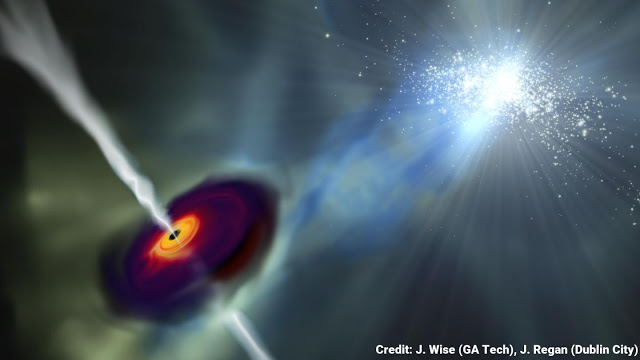

| Online: | |
| Visits: | |
| Stories: |

| Story Views | |
| Now: | |
| Last Hour: | |
| Last 24 Hours: | |
| Total: | |
New Theory Explains Formation of Supermassive Black Holes in the Very Early Universe
Observations in the past decade have demonstrated that extremely massive supermassive black holes were already in place when the Universe was less than 800 million years old. Supermassive black holes found at the centres of galaxies typically have masses of millions up to even billions of solar masses, whereas the black holes formed in the collapse of massive stars have masses around 5-20 solar masses.
The observations of extremely massive black holes in the very early Universe are somewhat surprising, since it is not straightforward to grow the mass of black hole from tens up to billions of solar masses in the limited time available, says Associate Professor Peter Johansson from University of Helsinki, who has developed a new simulation model to describe in more detail the formation of supermassive black holes in the early Universe.
A black hole grows most effectively through the accretion of gas, but when the gas hurls towards the black hole it heats up strongly due to friction forces and the strong gravitational field. The resulting hot gas radiates strongly and some fraction of the radiation couples with the infalling gas exerting strong radiation pressure, preventing further gas infall.
Thus black holes cannot be force-fed, as too much accretion results in a strong burst of radiation that pushes back the infalling gas.
When very large gas clouds collapse directly to seed supermassive black holes
During the last years an alternative model for the formation of supermassive black holes in the early Universe has been developed. In this so called “Direct collapse black hole model” very large gas clouds with masses of 10 000 -100 000 solar masses collapse directly to seed supermassive black holes.
A prerequisite for this direct collapse is that the gas cooling is very inefficient, as otherwise the collapsing gas cloud would fragment and result in star formation. In the very early Universe the only way of cooling gas at low temperatures was by emission from molecular hydrogen.
An article titled “Rapid formation of massive black holes in close proximity to embryonic protogalaxies” published in the prestigious Nature Astronomy journal on March 13th, 2017, shows for the first time that the near simultaneous formation of two galaxies can lead to a situation in which the radiation from the first galaxy can destroy the molecular hydrogen in the second galaxy just at the right time.
- In this way a massive direct collapse black hole seed can form in the second galaxy, which can evolve rather quickly to a billion solar mass black hole by the time they are observed in the Universe, Peter Johansson says.
The new simulation model describing the formation of supermassive black holes in the early Universe in more detail was developed at the University of Helsinki by Peter Johansson in close collaboration with Irish and American researchers.
Peter Johansson,
The research article published on the Nature Astronomy website, http://www.nature.com/articles/s41550-017-0075 and the open access version published on the ArXiv website: https://arxiv.org/abs/1703.03805 The main author of the article, Dr. John Regan (Dublin City University) was formerly a postdoctoral researcher at the University of Helsinki
Source:



